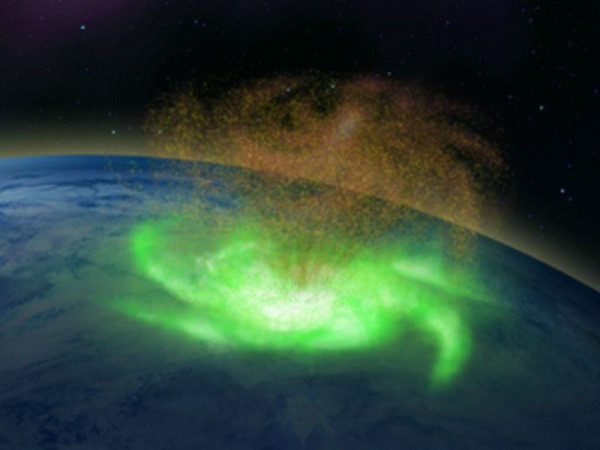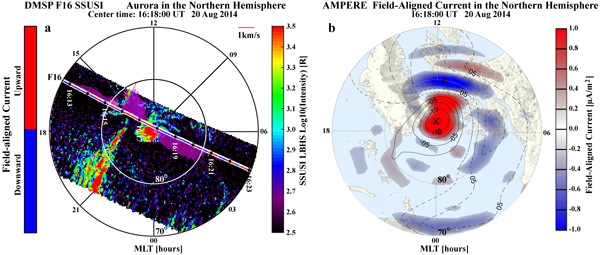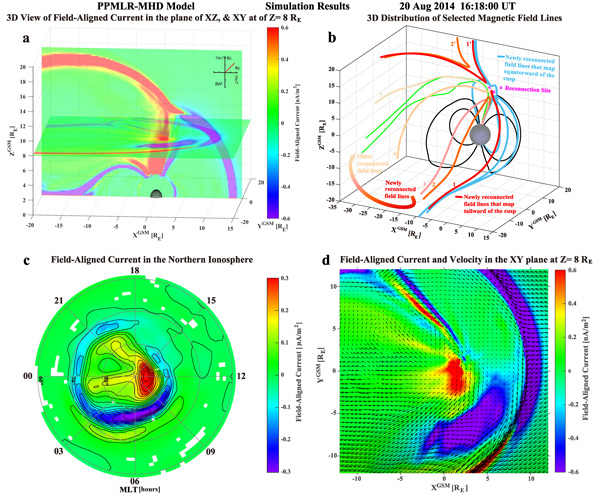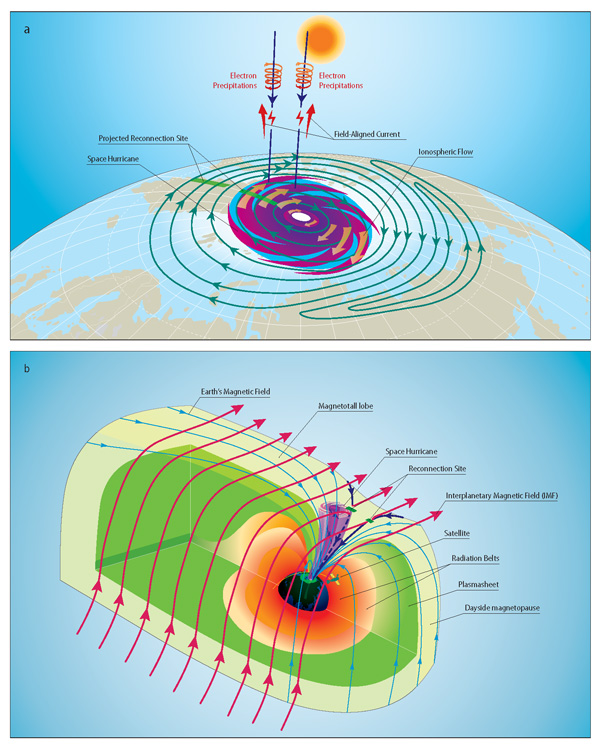2021 ARTEMIS SCIENCE NUGGETS
A Space Hurricane over the Earth's Polar Ionosphere
by Qing-He Zhang
Shandong Provincial Key Laboratory of Optical Astronomy and Solar-Terrestrial Environment
Institute of Space Sciences, Shandong University, Weihai, Shandong, 264209, China.
Introduction
In Earth's lower atmosphere, hurricanes often cause loss of life and property damage through high winds and flooding resulting from the coastal storm surge of the ocean and the torrential rains. They are characterized by a low-pressure center (hurricane eye), strong winds and flow shears, and a spiral arrangement of towering clouds with heavy rains. In space, astronomers have spotted hurricanes on Mars, and Saturn, and Jupiter, which are similar to terrestrial hurricanes. There are also solar gases swirling in monstrous formations deep within the sun's atmosphere, called solar tornadoes with widths of several Earth radii (RE).
| Figure 1. A schematic of a space hurricane over the Earth's polar ionosphere. Image courtesy of Qing-He Zhang. |
A hurricane is clearly associated with strong energy and mass transportation, so if there is a hurricane in Earth's upper atmosphere, it must be violent and efficiently transfer solar wind/magnetosphere energy and momentum into the Earth's ionosphere. However, hurricanes have never been reported in the upper atmosphere of planets in our heliosphere. In order to investigate this unsolved and challenging scientific problem, this paper presents the first discovery of a hurricane in Earth's polar ionosphere and magnetosphere, and names it a “space hurricane”, by comparing results from satellite observations and high-resolution global 3D MagnetoHydroDynamics (MHD) simulations.
Observations and Simulation Results
On 20th August 2014, a relatively stable northward IMF condition (IMF Bz > 0 for more than 8 hours) occurred with a large duskward component (IMF By = ~13 nT). ARTEMIS observed roughly stable interplanetary conditions with low solar wind speed and density outside the magnetosphere. Under these extremely quiet geomagnetic conditions, auroral observations from four DMSP satellites and AMPERE field-aligned current distributions in the Northern Hemisphere were available, presented in Figure 2. In Figure 2a, a cyclone-like auroral spot (diameter over 1000 km) with multiple arms and a trend of anti-clockwise rotation appeared around the north magnetic pole for about 8 hours, analogically named a space hurricane hereafter. This space hurricane exhibited the following characteristics: a spot-like strong upward FAC with a hole sometimes developed in the center, Figure 2b), zero horizontal flow near its center (the hurricane eye), as well as strong flow shears around the edges, ion upflows, enhanced electron temperature ~1000 K, a negative-to-positive bipolar magnetic structure implying a circular magnetic field perturbation, electron inverted-V acceleration to above 10 keV, and large and rapid deposition of energy and flux into the polar ionosphere.
| Figure 2. An example of aurora and FAC observations in the polar region of the Northern Hemisphere. a.) Aurora in the Lyman–Birge–Hopfield short-band (LBHS) band (wavelength of 140-150 nm), the measured cross-track horizontal ion flows shown in mauve drift vectors perpendicular to the orbit, and the sign of the FACs shown in red and blue color along the satellite track. The aurora is observed by the SSUSI instrument aboard the DMSP F16 satellite, the ion flow is measured by the special sensor for ions, electrons, and scintillation (SSIES) and the FAC is calculated from the magnetic field measurement of the special sensor microwave (SSM) instrument also on DMSP F16. b.) The distribution map of the FACs and potential of AMPERE magnetic perturbation data products derived from the Iridium satellites constellation. |
The precipitating electron energy flux was much stronger than during typical quiet and substorm conditions, and comparable to that during super storms. These factors indicate that the space hurricane can induce large and rapid deposition of energy and flux into the polar ionosphere during an otherwise extremely quiet geomagnetic condition, suggesting that current geomagnetic activity indicators do not properly represent the dramatic activity within space hurricanes, which are located further poleward than geomagnetic index observatories.
The space hurricane formation is further investigated by simulation using a high-resolution 3-D global MHD code and a piecewise parabolic method with a Lagrangian remap to MHD (PPMLR-MHD), which uses the measured interplanetary conditions as inputs. The simulation results show a strong upward FAC funnel that appears to nearly link the polar ionosphere to the inner edge of the high-latitude magnetopause FAC belt, shown in the center of Figure 3a. The 3D topology of selected magnetic field lines suggests that there is magnetic reconnection occurring between the IMF and Earth's magnetic field at the dayside magnetopause around both the tailward (red lines) and equatorward (light blue lines) field lines of the cusp (Figure 3b). The reconnected open field lines link to the northern hemisphere, and tend to move dawnward and then tailward from the morning side to the afternoon side in the high-latitude lobe region (highlighted by the colored and numbered field lines and an arrowed curve in Figure 3b). The funnel of the FAC appears as a spot with several arms and a trend of anti-clockwise rotation (Figure 3d), consistent with the DMSP SSUSI auroral and plasma observations. These upward FACs (both from the simulation and observations) cause magnetic field-aligned acceleration of magnetospheric electrons (probably through the Knight current-voltage process to keep current continuity) that precipitate into the polar ionosphere and generate the hurricane structure in the aurora (Figure 4a).
| Figure 3. 3-D and 2-D view of simulated FACs and selected magnetic field lines by the PPMLR-MHD code at the center time of the example in Figure 2a. a.) 3-D view of the simulated FACs in the GSM X-Z plane, and the X-Y plane at Z=8 RE; b.) 3-D distribution of selected magnetic field lines with magenta crosses representing the reconnection sites and the numbered field lines in red to light brown representing the newly to old evolution of the reconnected field lines that also highlighted by the thick arrowed color curve; c.) 2-D distribution of simulated FACs in the northern polar ionosphere with FAC contour lines, and d. close-up view of the 2-D distribution of FACs and plasma velocity vectors in the X-Y plane at Z=8 RE. |
The simulation results suggest that magnetic reconnection occurs steadily in the high latitude lobe region for an extended period of time, during a several hour period of stable northward IMF and very low solar wind density and speed. After lobe reconnection, the newly reconnected open field lines are draped by the solar wind to move dawnward and then tailward from the morning side to the afternoon side in the high-latitude lobe region and will gradually return to their previous positions and participate in a new cycle of magnetic reconnection (Figure 4b). Their evolution will eventually form a cyclone-shaped funnel of FAC with multiple FAC arms and a clockwise circulation of the plasma flow, due to the pressure gradient and magnetic stresses on both sides of the funnel for completing the FACs and the flow shear and curvature of the circular flow. Inside the funnel, a corkscrew magnetic field forms with circular flow and upward FACs, which accelerate electrons that precipitate into the ionosphere and create the auroral spot with multiple arms. This means that the space hurricane opens a rapid energy transfer channel from space to the ionosphere and thermosphere.
This study suggests that despite northward IMF, there are still local intense geomagnetic disturbances and energy depositions which are comparable to those during super storms. This finding can improve our understanding of coupling processes in the solar wind, magnetosphere and ionosphere under extremely quiet geomagnetic conditions. In addition, the space hurricane could contribute to important space weather effects like increased satellite drag, disturbances in High Frequency (HF) radio communications, and increased errors in over-the-horizon radar location, satellite navigation, and communication systems.
| Figure 4. Schematic of the space hurricane and its formation mechanism during an extremely quiet geomagnetic condition with northward IMF and a dominant By component. a.) Schematic of a space hurricane in the northern polar ionosphere. The magenta cyclone-shape auroral spot with brown thick arrows of circular ionospheric flows represents the space hurricane with a light green background showing the downward FACs. Convection streamlines are in blue with green thick crossed bars that show the projected magnetic reconnection sites at the dayside magnetopause around the equatorward and tailward (lobe) boundary of the cusp. The vertical dark blue lines represent the Earth's magnetic field lines with electron precipitation and FACs. The sun is on top representing the polar ionosphere under sunlit conditions during the interval of interest. b.) Schematic of the 3-D magnetosphere when the space hurricane occurred. Different color shadings represent different regions of the magnetosphere. The shaded magenta funnel shows the space hurricane in the magnetosphere. Red, black and blue curves with arrows are the interplanetary magnetic field lines, Earth's magnetic field lines, and newly reconnected Earth's magnetic field lines, respectively. The green thick bars represent the reconnection sites. The yellow curve with a satellite icon shows the satellite orbit. In this case, magnetopause reconnection can take place at the dayside magnetopause around the equatorward and tailward (lobe) boundary of the cusp. Due to a steady high-latitude lobe reconnection, a funnel (space hurricane) formed just poleward of the cusp region (Figure 4b), and a large ionospheric convection lobe-cell with strong circular horizontal plasma flow inside the normal afternoon convection cell (Figure 4a). |
Conclusion
This paper reports a long-lasting space hurricane in the polar ionosphere and magnetosphere during low solar and otherwise low geomagnetic activity. This hurricane shows strong circular horizontal plasma flow with shears, a nearly zero-flow center, and a coincident cyclone-shaped aurora caused by strong electron precipitation associated with intense upward magnetic field-aligned currents. Near the center, precipitating electrons were substantially accelerated to ~10 keV. The hurricane imparted large energy and momentum deposition into the ionosphere despite otherwise extremely quiet conditions. The observations and simulations reveal that the space hurricane is generated by steady high-latitude lobe magnetic reconnection and current continuity during a several hour period of northward interplanetary magnetic field and very low solar wind density and speed. The reconnection leads to formation of a cyclone-shaped funnel that generates an intense field aligned current and electron acceleration. This study shows large and rapid deposition of solar wind/magnetosphere energy and momentum into the ionosphere around the magnetic pole unlike the expectation during extremely quiet geomagnetic conditions.
References
Zhang, Q. -H., et al. (2021), A space hurricane over the Earth's polar ionosphere, Nature Communications, doi: 10.1038/s41467-021-21459-yBiographical Note
Dr. Qing-He Zhang is a professor at the Institute of Space Sciences, Shandong University, China, and leads a group of ionosphere-magnetosphere coupling and space weather research as a PI. He and his group focus on the research of ionosphere-magnetosphere coupling and associated space weather effects, and have made a series of progresses, such as fully tracking the large-scale Dungey convection cycle by using polar cap ionospheric patches, and the formation of multiple transpolar arcs, etc. Relevant works have been published in Science as an issue highlight [Zhang et al., Science, 339, 1597-1600 (2013)], in Journal Geophysics Researches: Space Physics as a cover letter paper [Zhang et al., JGR, 121, 9063–9074 (2016)], and in PNAS [Zhang et al., PNAS, 117(28), 16193–16198 (2020)], etc.
 Please send comments/suggestions to
Emmanuel Masongsong / emasongsong @ igpp.ucla.edu
Please send comments/suggestions to
Emmanuel Masongsong / emasongsong @ igpp.ucla.edu



